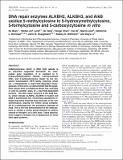| dc.contributor.author | Bian, Ke | |
| dc.contributor.author | Lenz, Stefan A P | |
| dc.contributor.author | Tang, Qi | |
| dc.contributor.author | Chen, Fangyi | |
| dc.contributor.author | Qi, Rui | |
| dc.contributor.author | Jost, Marco | |
| dc.contributor.author | Drennan, Catherine L | |
| dc.contributor.author | Essigmann, John M | |
| dc.contributor.author | Wetmore, Stacey D | |
| dc.contributor.author | Li, Deyu | |
| dc.date.accessioned | 2020-05-12T15:37:29Z | |
| dc.date.available | 2020-05-12T15:37:29Z | |
| dc.date.issued | 2019-05 | |
| dc.date.submitted | 2019-04 | |
| dc.identifier.issn | 0305-1048 | |
| dc.identifier.issn | 1362-4962 | |
| dc.identifier.uri | https://hdl.handle.net/1721.1/125181 | |
| dc.description.abstract | 5-Methylcytosine (5mC) in DNA CpG islands is an important epigenetic biomarker for mammalian gene regulation. It is oxidized to 5-hydroxymethylcytosine (5hmC), 5-formylcytosine (5fC), and 5-carboxylcytosine (5caC) by the ten-eleven translocation (TET) family enzymes, which are -ketoglutarate (-KG)/Fe(II)-dependent dioxygenases. In this work, we demonstrate that the epigenetic marker 5mC is modified to 5hmC, 5fC, and 5caC in vitro by another class of -KG/Fe(II)-dependent proteins-the DNA repair enzymes in the AlkB family, which include ALKBH2, ALKBH3 in huamn and AlkB in Escherichia coli. Theoretical calculations indicate that these enzymes may bind 5mC in the synconformation, placing the methyl group comparable to 3-methylcytosine, the prototypic substrate of AlkB. This is the first demonstration of the AlkB proteins to oxidize a methyl group attached to carbon, instead of nitrogen, on a DNA base. These observations suggest a broader role in epigenetics for these DNA repair proteins. | en_US |
| dc.description.sponsorship | National Institute of General Medical Sciences (Grant P20 GM103430) | en_US |
| dc.description.sponsorship | National Cancer Institute (Grant P01 CA026731) | en_US |
| dc.description.sponsorship | National Cancer Institute (Grant R01 CA080024) | en_US |
| dc.description.sponsorship | National Cancer Institute (Grant P30 ES002109) | en_US |
| dc.language.iso | en | |
| dc.publisher | Oxford University Press (OUP) | en_US |
| dc.relation.isversionof | http://dx.doi.org/10.1093/nar/gkz395 | en_US |
| dc.rights | Creative Commons Attribution NonCommercial License 4.0 | en_US |
| dc.rights.uri | https://creativecommons.org/licenses/by-nc/4.0/ | en_US |
| dc.source | Nucleic Acids Research | en_US |
| dc.title | DNA repair enzymes ALKBH2, ALKBH3, and AlkB oxidize 5-methylcytosine to 5-hydroxymethylcytosine, 5-formylcytosine and 5-carboxylcytosine in vitro | en_US |
| dc.type | Article | en_US |
| dc.identifier.citation | Bian,Ke et al. "DNA repair enzymes ALKBH2, ALKBH3, and AlkB oxidize 5-methylcytosine to 5-hydroxymethylcytosine, 5-formylcytosine and 5-carboxylcytosine in vitro." Nucleic Acids Research 47, 11 (June 2019): 5522–5529. ©2019 The Author(s). | en_US |
| dc.contributor.department | Massachusetts Institute of Technology. Department of Chemistry | en_US |
| dc.contributor.department | Massachusetts Institute of Technology. Department of Biology | en_US |
| dc.contributor.department | Massachusetts Institute of Technology. Center for Environmental Health Sciences | en_US |
| dc.contributor.department | Massachusetts Institute of Technology. Department of Biological Engineering | en_US |
| dc.relation.journal | Nucleic Acids Research | en_US |
| dc.eprint.version | Final published version | en_US |
| dc.type.uri | http://purl.org/eprint/type/JournalArticle | en_US |
| eprint.status | http://purl.org/eprint/status/PeerReviewed | en_US |
| dc.date.updated | 2019-12-03T19:26:51Z | |
| dspace.date.submission | 2019-12-03T19:26:53Z | |
| mit.journal.volume | 47 | en_US |
| mit.journal.issue | 11 | en_US |
| mit.metadata.status | Complete | |
